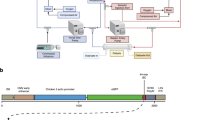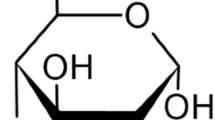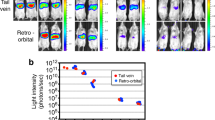Abstract
Hydrodynamic injection is an efficient procedure for liver gene therapy in rodents but with limited efficacy in large animals, using an ‘in vivo’ adapted regional hydrodynamic gene delivery system. We study the ability of this procedure to mediate gene delivery in human liver segments obtained by surgical resection. Watertight liver segments were retrogradely injected from hepatic vein with a saline solution containing a plasmid bearing the enhanced green fluorescent protein (eGFP) gene, under different conditions of flow rate (1, 10 and 20 ml s–1) and final perfused volume. Samples were cultured for 1 to 2 days and used for microscopy and molecular analysis of gene expression. The fluorescent and immunohistochemistry studies indicated that in segments injected at ⩾10 ml s–1, good and wide gene expression was present in the liver sections and the molecular analysis reinforced the histological observation in a quantitative manner (index of apparent gene delivery: 102–104 eGFP DNA copy per 100 pg of total DNA; transcription index: 105–2 × 106 eGFP RNA copy per 100 ng of total RNA). In addition, injected gold nanoparticles (15 nm diameter) suggested that DNA delivery to hepatocytes must involve a facilitated permeation process without membrane disruption. In summary, we show that retrograde venous injection of watertight human liver segment is an anadromous procedure that results in wide liver gene delivery and good gene expression. However, additional studies will be necessary to clarify the influence of the prolonged ischemia injury to hepatocytes in our model.
This is a preview of subscription content, access via your institution
Access options
Subscribe to this journal
Receive 12 print issues and online access
$259.00 per year
only $21.58 per issue
Buy this article
- Purchase on Springer Link
- Instant access to full article PDF
Prices may be subject to local taxes which are calculated during checkout







Similar content being viewed by others
References
Liu F, Song YK, Liu D . Hydrodynamics-based transfection in animals by systemic administration of plasmid DNA. Gene Therapy 1999; 6: 1258–1266.
Aliño SF, Crespo A, Dasí F . Long-term therapeutic levels of human alpha-1-antitrypsin in plasma after hydrodynamic injection of nonviral DNA. Gene Therapy 2003; 10: 1672–1679.
Khorsandi SE, Bachellier P, Weber JC, Greget M, Jaeck D, Zacharoulis D et al. Minimally invasive and selective hydrodynamic gene therapy of liver segments in the pig and human. Cancer Gene Ther 2008; 15: 225–230.
Herrero MJ, Dasi F, Noguera I, Sanchez M, Moret I, Sanmartin I et al. Mouse and pig nonviral liver gene therapy: success and trials. Gene Ther Mol Biol 2005; 9: 169–180.
Aliño SF, Herrero MJ, Noguera I, Dasi F, Sanchez M . Pig liver gene therapy by noninvasive interventionist catheterism. Gene Therapy 2007; 14: 334–343.
Aliño SF, Herrero MJ, Bodi V, Noguera I, Mainar L, Dasi F et al. Naked DNA delivery to whole pig cardiac tissue by coronary sinus retrograde injection employing non-invasive catheterization. J Gene Med 2010; 12: 920–926.
Sawyer GJ, Zhang X, Fabre JW . Technical requirements for effective regional hydrodynamic gene delivery to the left lateral lobe of the rat liver. Gene Therapy 2010; 17: 560–564.
Crespo A, Peydro A, Dasi F, Benet M, Calvete JJ, Revert F et al. Hydrodynamic liver gene transfer mechanism involves transient sinusoidal blood stasis and massive endocytic vesicles. Gene Therapy 2005; 12: 927–935.
McTiernan CF, Mathier MA, Zhu X, Xiao X, Klein E, Swan CH et al. Myocarditis following adeno-associated viral gene expression of human soluble TNF receptor (TNFRII-Fc) in baboon hearts. Gene Therapy 2007; 14: 1613–1622.
Zhang G, Budker V, Wolf JA . High levels of foreign gene expression in hepatocytes after tail vein injections of naked plasmid DNA. Hum Gene Ther 1999; 10: 1735–1737.
Hoshino K, Kimura T, De Grand AM, Yoneyama R, Kawase Y, Houser S et al. Three catheter-based strategies for cardiac delivery of therapeutic gelatin microspheres. Gene Therapy 2006; 13: 1320–1327.
Suda T, Suda K, Liu D . Computer-assisted hydrodynamic gene delivery. Mol Ther 2008; 16: 1098–1104.
Fabre JW, Grehan A, Whiterhorne M, Sawyer GJ, Dong X, Salehi S et al. Hydrodynamic gene delivery to the pig liver via an isolated segment of the inferior vena cava. Gene Therapy 2008; 15: 452–462.
Kamimura K, Suda T, Xu W, Zhang G, Liu D . Image-guided, lobe-specific hydrodynamic gene delivery to swine liver. Mol Ther 2009; 17: 491–499.
Eastman SJ, Baskin KM, Hodges BL, Chu Q, Gates A, Dreusicke R et al. Development of catheter-based procedures for transducing the isolated rabbit liver with plasmid DNA. Hum Gene Ther 2002; 13: 2065–2077.
Gregory TR . Animal Genome Size Database (2010). http://www.genomesize.com (accessed on April 2010).
Sawyer GJ, Rela M, Davenport M, Whitehorne M, Zhang X, Fabre JW . Hydrodynamic gene delivery to the liver: theoretical and practical issues for clinical application. Curr Gene Ther 2009; 9: 128–135.
Fabre JW, Whitehorne M, Grehan A, Sawyer GF, Zhang X, Davenport M et al. Critical physiological and surgical considerations for hydrodynamic pressurisation of individual segments of the pig liver. Human Gene Ther 2010; 22: 879–887.
Zhang G, Gao X, Song YK, Volimer R, Stolz DB, Gasiorowski JZ et al. Hydroporation as the mechanism of hydrodynamic delivery. Gene Therapy 2004; 11: 675–682.
Sebestyén MG, Budker VG, Budker T, Subbotin VM, Zhang G, Monahan SD et al. Mechanism of plasmid delivery by hydrodynamic tail vein injection. I. Hepatocyte uptake of various molecules. J Gene Med 2006; 8: 852–873.
Suda T, Gao X, Stolz DB, Liu D . Structural impact of hydrodynamic injection on mouse liver. Gene Therapy 2007; 14: 129–137.
Si ZZ, Li JQ, Ai HA, He ZJ, Hu W, Li YN . Recombinant adenovirus vector Ad-hIL-10 protects grafts from cold ischemia-reperfusion injury following orthotopic liver transplantation in rats. Hepatobiliary Pancreat Dis Int 2010; 9: 144–148.
Kimling J, Maier M, Okenve B, Kotaidis V, Ballot H, Plech A . Turkevich method for gold nanoparticle synthesis revisited. J Phys Chem 2006; 110: 157–160.
Acknowledgements
We thank Mr Alejo Sempere from the Department of Pathology, University of Valencia, for the immunohistochemistry, the SCSIE from the University of Valencia for the electron microscopy and A Gonzalez and ML Lozano from CIEMAT/CIBERER for qPCR analysis. This work has been partially supported by projects from the Generalidad Valenciana (AP-095/09) and the Ministerio de Ciencia e Innovación (SAF2007–64492 and SAF2011–27002).
Author information
Authors and Affiliations
Corresponding author
Ethics declarations
Competing interests
The authors declare no conflict of interest.
Rights and permissions
About this article
Cite this article
Herrero, M., Sabater, L., Guenechea, G. et al. DNA delivery to ‘ex vivo’ human liver segments. Gene Ther 19, 504–512 (2012). https://doi.org/10.1038/gt.2011.144
Received:
Revised:
Accepted:
Published:
Issue Date:
DOI: https://doi.org/10.1038/gt.2011.144
Keywords
This article is cited by
-
Recent advances in the development of gene delivery systems
Biomaterials Research (2019)
-
Human AAT gene transfer to pig liver improved by using a perfusion isolated organ endovascular procedure
European Radiology (2016)
-
Novel electric power-driven hydrodynamic injection system for gene delivery: safety and efficacy of human factor IX delivery in rats
Gene Therapy (2013)
-
Parameters Affecting Image-guided, Hydrodynamic Gene Delivery to Swine Liver
Molecular Therapy - Nucleic Acids (2013)



